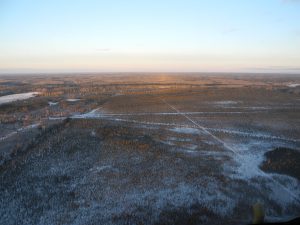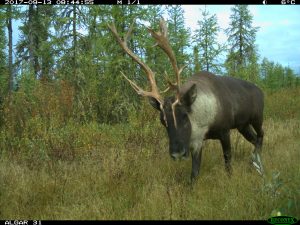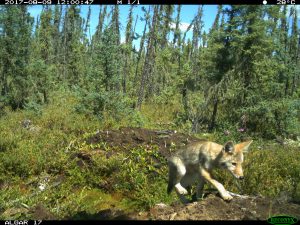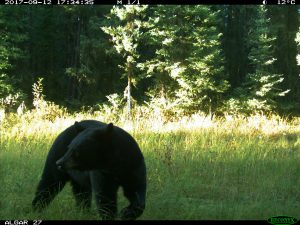A tale of field work in Alberta’s boreal forest
The helicopter lifts into the sky, blasting us with an icy wash of winter air and snow crystals. As the engine’s roar fades into the distance, we trudge across the frozen ground, each step a struggle to avoid sinking into the waterlogged sphagnum. My GPS counts down metres to our target and I feel a slight sense of eager anticipation and nerves. The camera trap we are approaching could contain a record of all the wildlife that passed by this summer, or, like too many this year, it could have failed for reasons unknown.
I spend my entire year reading about this landscape: the boreal forest of northern Alberta. Sitting in my office thousands of kilometres away, I dig through journal articles for factoids that could add to my research. I hone in on keywords like ‘woodland caribou,’ ‘anthropogenic disturbances,’ ‘linear features,’ ‘grey wolves,’ and ‘habitat fragmentation.’ I frame what I know about this system in scientific terms. I paint a scene of wildlife (and wild life) using ecological theories, human impacts on the natural world, and corporate reports on restoration and mitigation strategies. From this, I build a web of interactions for my study species: the energy industry cuts linear corridors across the boreal landscape, tilting the scales in favour of grey wolves, white-tailed deer, and moose while at the same time threatening populations of woodland caribou. My research questions add in additional layers: does habitat restoration change these relationships? Do these changes have rippling effects throughout the boreal mammal community? What effects have we overlooked? The system I describe has all the delightful complexity that first drew me to this field of research, yet it is simple enough to outline on paper.
Then we plan our field work. The northern boreal is remote and wet, leaving us only short windows of time to access our sites when the ground is frozen but the snow is not yet too deep. We recraft old field plans and revise data sheets. We try to recall what worked and what needed to be re-worked from our last visit. We discuss new measurements to record. We decide what is feasible within the brief time spent at each of our 60 camera sites. We devise a plan of attack that most efficiently utilizes helicopter time. With such infrequent visits to our camera sites, planning and preparation are vital to successful data collection.
This well-laid strategy tumbles to the back of my mind as soon as the helicopter wash settles and the forest’s stillness reclaims its hold on the boggy landscape. I fight the overwhelming urge to abandon our tasks and stand in wonder. The weak sunlight glints off ice suspended in the air, while the black spruce glows golden-green to complete the ethereal scene. These trees are over one hundred years old, yet some of them are no thicker than my calf and stand no taller than 5 metres. We fumble through the first camera station, putting our paper procedures into practice. Although the motions soon become routine, unexpected disruptions inevitably arise. A grey jay pecked out a camera’s motion detector in June at one site. The camera tree toppled over in September at another. For far too many cameras this year, the memory card failed for unexplained reasons. My sense of control over the situation is quickly replaced by panic at losing it, and then finally by acceptance and adaptation.
Even my perceived understanding of this system soon unravels when standing in the middle of it. As the day wears on I list in my head countless additional factors that complicate the tidy interaction network I envisioned. How could my handful of chosen variables even begin to explain a moose’s movement choices? How can statistics and models describe a fraction of what influences caribou habitat selection? The fact that camera detections can estimate these questions was mildly impressive in the literature. Now, faced with the living system, this seems like nothing short of a miracle.
In the evening, I download and sift through the digital treasures we collected that day. The images portray wildlife going about their daily activities in the very places I stood hours before. Moose graze willow shrubs; caribou lumber across the field of view. Wolf packs flash by in a furry blur. Although we’ve lost data, the precious gems we have recovered restore some of my lost hope. They tell a rich story of a world rarely seen by human eyes. I may not be able to capture all of boreal life in my short study, but perhaps these snapshots will help me bring a few details into clearer focus.



